Assessing Characteristics of Strong Dynamic Loads in Deep Coal Mining and Their Mechanisms in Triggering Secondary Disasters
Abstract
:1. Introduction
- If the length N of the signal is not a power of 2, perform zero-padding to make it a power of 2.
- Divide the signal into equal halves and recursively compute each half.
- Merge the results of the two halves through butterfly operations to obtain the final frequency-domain result.
2. Materials and Methods
2.1. The Source of Strong Dynamic Load Data
2.2. Method for Seismic Source Parameters
2.3. Peak Decay Analysis
- Determine the peak values on the velocity curve of the original signal after the peak.
- Fit these peak values using spline interpolation to form the upper envelope after the peak.
- Based on the exponential decay law, fit the upper envelope after the peak using a fitting formula.
2.4. Multifractal Detrended Fluctuation Analysis (MFDFA) Method
- Remove the mean value of Xk and reconstruct the signal as in Equation (9).
- Divide Yi into Ns non-overlapping segments of length s. Since the signal length N is usually not a multiple of s, the remaining data segments are not usable. To address the data alignment issue, perform the same segmentation on the signal in reverse order, resulting in 2 Ns data segments.
- Use the least squares method to calculate the local trend on each segment v (v = 1, …, 2 Ns). Then, calculate the variance of each segment after removing the trend fluctuations, using Equation (10).
- For the 2 Ns segments, calculate the qth order fluctuation function F (q, s), using Equation (11).where q represents the fluctuation weight factor.
- If the strong mine seismic signal Xk exhibits self-similarity, then F (q, s) is in exponential relation with s, as shown as in Equation (12).where h(q) represents the generalized Hurst exponent.
- Based on h(q), the multifractal scaling exponent τ(q) can be calculated using Equation (13).
- Furthermore, through Legendre transformation, two parameters can be calculated to describe multifractal characteristics in Equations (14) and (15).
- The width Δα of the multifractal spectrum can describe the unevenness of the seismic waveform. A larger value indicates more severe waveform fluctuations, whereas a smaller value suggests a stable waveform, which represents the ratio of large peaks to small peaks in the seismic waveform. When , the proportion of large amplitudes is higher, while when , the proportion of small amplitudes is higher. The width of the multifractal spectrum Δα is calculated by Equation (17).
- In addition, in the field of earthquakes, vibration velocity is often used as an evaluation criterion for vibration intensity. The three types of mine shock waves can be distinguished by the particle peak particle vibration velocity (PPV) attenuation coefficient. PPV propagates in the formation with a power exponential attenuation, and its relationship with the propagation distance can be expressed as Equation (17).where vpp is the peak particle velocity at a distance of d m from the source; v0 is the peak particle velocity at the source; and α is the velocity attenuation coefficient.
2.5. FLAC3D 5.0 Model Building
3. Results and Discussion
3.1. Strong Dynamic Load Temporal Classification and Spatiotemporal Distribution
3.2. Strong Seismic Load Waveform Data and Source Parameter Analysis
3.3. Waveform Analysis
3.3.1. Principal Frequency Analysis
3.3.2. Peak Decay Amplitude Analysis
3.3.3. Multifractal Feature Analysis
3.4. Analysis of Disaster Effects Caused by Different Types of Dynamic Loads
3.4.1. Velocity Field Evolution Law
3.4.2. Evolutionary Law of Stress Field Through Numerical Simulation
4. Conclusions
- (1)
- Based on the Brune model, the seismic source parameters of strong dynamic loads were estimated and analyzed. It was found that the seismic moment and radiated energy of various types of dynamic loads are positively correlated. Under the same conditions of radiated energy, the seismic moment is the greatest for coal pillar-type dynamic loads, followed by roof-type dynamic loads, with fault-type dynamic loads being the smallest. Additionally, under the same seismic source radius conditions, fault-type dynamic loads result in the largest increase in volume due to non-elastic deformation of the rupture source, followed by coal pillar-type dynamic loads, and then roof-type dynamic loads. Fault-type dynamic loads have the smallest rupture strength and scale, but exhibit higher stress drops, with the greatest magnitude of stress level adjustment or release, followed by coal pillar-type dynamic loads, and then roof-type dynamic loads.
- (2)
- Based on the analysis of the frequency spectrum and multifractal features of strong dynamic load waveforms using FFT and MFDFA, it was found that the first dominant frequency of the three types of strong dynamic loads tends to cluster. Based on this, it is inferred that the frequency boundary lines of the three types of signals lie within the range of 30–60 HZ. The post-peak decay coefficients of the waveforms for the three types of strong dynamic load events differ, with average values for roof-type, coal pillar-type, and fault-type being 1.41, 1.57, and 4.53, respectively. Regarding multifractal features, coal pillar-type strong dynamic load waves exhibit the highest degree of waveform fluctuation, followed by roof-type, and then fault-type.
- (3)
- Numerical simulations were conducted to analyze the dynamics of three typical types of strong dynamic loads, obtaining velocity response characteristics during their propagation. The results indicated that during the propagation process, the frequency attenuation regions differ: roof-type dynamic load waves exhibit significant attenuation in the low-frequency range (from 0 Hz to 35 Hz), while fault-type dynamic load waves show broader significant attenuation (from 0 Hz to 80 Hz). Coal pillar-type dynamic load waves exhibit attenuation regions similar to fault-type, but with the fastest attenuation in the 0–10 Hz range, where low-frequency components rapidly decay during propagation. Furthermore, peak vibration velocity decreases with increasing propagation distance, with attenuation coefficients of 0.0034, 0.0027, and 0.0018 for roof-type, fault-type, and coal pillar-type dynamic load waves, respectively.
Author Contributions
Funding
Institutional Review Board Statement
Informed Consent Statement
Data Availability Statement
Acknowledgments
Conflicts of Interest
References
- Jiang, Y.; Pan, Y.; Jiang, F.; Dou, L.; Ju, Y. State of the art review on mechanism and prevention of coal bumps in China. J. China Coal Soc. 2014, 39, 205–213. [Google Scholar] [CrossRef]
- Dou, L.; Cao, J.; Cao, A.; Chai, Y.; Bai, J.; Kan, J. Research on types of coal mine tremor and propagation law of shock waves. Coal Sci. Technol. 2021, 49, 23–31. [Google Scholar]
- Jiang, F.; Zhang, X.; Zhu, S. Discussion on key problems in prevention and control system of coal mine rock burst. Coal Sci. Technol. 2023, 51, 203–213. [Google Scholar]
- Stec, K.; Blaszczyk, E. Characteristics of the processes taking place at the sources high energy tremors occurring during mining of coalface no 17 in coal seam no 361 of the Knurow coal mine. Gospod. Surowcami Miner. Miner. Resour. Manag. 2008, 24, 245–259. [Google Scholar]
- Gu, X.; Zhang, C.; Guo, W.; Zhang, Y.; Gong, X.; Wang, C.; Zhao, X.; Zhang, L. Characteristics and recognition of typical micro-seismic signals in rock burst mines. J. China Coal Soc. 2024, 49, 694–713. [Google Scholar]
- Jiao, Y.; Wu, K.; Zou, J.; Zheng, F.; Zhang, X.; Wang, C.; Li, X.; Zhang, C. On the strong earthquakes induced by deep coal mining under thick strata-a case study. Geomech. Geophys. Geo-Energy Geo-Resour. 2021, 7, 1–11. [Google Scholar] [CrossRef]
- Zhai, X.; Liu, Q.; Zhao, X.; Qian, H. Coal bump risk assessment and mine earthquake occurrence characteristics analysis of fully mechanized caving face under hugely-thick conglomerate stratum. J. Henan Polytech. Univ. Nat. Sci. 2023, 42, 1–10. [Google Scholar] [CrossRef]
- Zhang, Y.; Ji, H.; Wu, H. Triggering and relationship between mine earthquake activities and stress of earth tides during deep mining. Front. Earth Sci. 2022, 10, 889545. [Google Scholar] [CrossRef]
- Gao, M.; Dou, L.; Zhang, N.; Mu, Z.; Wang, K.; Yang, B. Experimental study on earthquake tremor for transmitting law of rockburst in geomaterials. Chin. J. Rock Mech. Eng. 2007, 26, 1365–1371. [Google Scholar]
- Cao, A.; Fan, J.; Mu, Z.; Guo, X. Burst failure effect of mining-induced tremor on roadway surrounding rock. J. China Coal Soc. 2010, 35, 2006–2010. [Google Scholar]
- Ye, G.; Jiang, F.; Guo, Y.; Wang, C. Experimental research on seismic wave attenuation by field micro-seismic monitoring in a deep coal mine. Chin. J. Rock Mech. Eng. 2008, 27, 1053–1058. [Google Scholar]
- Dou, L.; Bai, J.; Li, X.; He, H. Study on prevention and control technology of rockburst disaster based on theory of dynamic and static combined load. Coal Sci. Technol. 2018, 46, 1–8. [Google Scholar] [CrossRef]
- Tan, Y.; Guo, W.; Zhao, T.; Zhang, D.; Gu, X.; Tan, Y. Development and application of a novel deep roadway test system with dynamic-static loading. Chin. J. Rock Mech. Eng. 2022, 41, 1513–1524. [Google Scholar]
- Mendecki, M.J.; Szczygieł, J.; Lizurek, G.; Teper, L. Mining-triggered seismicity governed by a fold hinge zone: The Upper Silesian Coal Basin, Poland. Eng. Geol. 2020, 274, 105728. [Google Scholar]
- Cook, N.G.W. The failure of rock. Int. J. Rock Mech. Min. Sci. 1965, 2, 389–403. [Google Scholar] [CrossRef]
- Tan, Y.; Guo, W.; Gu, Q.; Zhao, T.; Yu, F.; Hu, S.; Yin, Y. Research on the rockburst tendency and AE characteristics of inhomogeneous coal-rock combination bodies. Shock Vib. 2016, 1, 9271434. [Google Scholar] [CrossRef]
- Diest, F.H. A non-linear continuum approach to the problem of fracture zones and rockbursts. J. S. Afr. Inst. Min. Metall. 1965, 65, 502–522. [Google Scholar]
- Cook, N.G.W. A note on rock bursts considered as a problem of stability. J. S. Afr. Inst. Min. Metall. 1965, 65, 437–446. [Google Scholar]
- Linkov, A.M. Rock bursts and the instability of rock masses. Int. J. Rock Mech. Min. Sci. Geomech Abstr. 1996, 33, 727–732. [Google Scholar] [CrossRef]
- Bieniawski, Z.T. Mechanism of brittle fracture of rock: Part II—Experimental studies. Int. J. Rock Mech. Min. Sci. Geomech Abstr. 1967, 4, 407–423. [Google Scholar] [CrossRef]
- Kidybiński, A. Bursting liability indices of coal. Int. J. Rock Mech. Min. Sci. 1981, 18, 295–304. [Google Scholar] [CrossRef]
- Zhang, M.; Zhao, B.; Xu, Z.; Benjun, Z.; Zenghe, X. Mechanism, Prediction, and Prevention of Rockburst. Saf. Coal Mines. 1988, 43–44. [Google Scholar]
- Zhang, M. Theory and numerical simulation of rockburst instability. Chin. J. Rock Mech. Eng. 1987, 197–204. [Google Scholar]
- Qi, Q.; Liu, T.; Shi, Y.; Lv, J. Frictional sliding instability mechanism of rockburst. J. Min. Saf. Eng. 1995, 174–177. [Google Scholar]
- Qi, Q.; Gao, Z.; Wang, S. Theory of rockburst causing structural damage in layered coal rock mass. Coal Min. Technol. 1998, 14–17. [Google Scholar]
- Khorrami, M.; Shokri, S.; Ghaffari, H. Hybrid seismic inversion for source parameters of the 2021 Kermanshah earthquake. Seismol. Res. Lett. 2023, 94, 1559–1573. [Google Scholar]
- Zhang, Y.; Liu, Q.; Zhang, D. Source parameters of the 2021 M7.2 Haiti earthquake from waveform inversion. Geophys. J. Int. 2024, 227, 1609–1627. [Google Scholar]
- Aslan, A.; Efe, H.; Pinar, A. Seismic source parameters and fault rupture characteristics of the 2023 Turkey-Syria earthquake. Earth Planet. Sci. Lett. 2023, 608, 258–270. [Google Scholar]
- Cao, A.; Dou, L.; Mou, Z.; Lu, C. 4.4.2 Coal and rock vibration classification based on vibration wave field characteristics. In Mining Geophysical Theory and Technology, 1st ed.; Li, X., Zhang, X., Eds.; China Science Publishing & Media Ltd.: Beijing, China, 2014; pp. 83–84. [Google Scholar]
- Aki, K. Scaling law of seismic spectrum. J. Geophys. Res. 1967, 72, 1217–1231. [Google Scholar] [CrossRef]
- Brune, J.N. Tectonic stress and the spectra of seismic shear waves from earthquakes. J. Geophys. Res. 1970, 75, 4997–5009. [Google Scholar] [CrossRef]
- Steketee, J.A. On Volterra’s dislocations in a semi-infinite elastic medium. Can. J. Phys. 1958, 36, 192–205. [Google Scholar] [CrossRef]
- Shearer, P.M. Introduction to Seismology, 3rd ed.; Cambridge University Press: Cambridge, UK, 2019. [Google Scholar]
- Archuleta, R.J.; Cranswick, E.; Mueller, C.; Spudich, P. Source parameters of the 1980 Mammoth Lakes, California, earthquake sequence. J. Geophys. Res. Solid Earth 1982, 87, 4595–4607. [Google Scholar] [CrossRef]
- Mandelbrot, B. How long is the coast of britain? Statistical self-similarity and fractional dimension. Science 1967, 156, 636–638. [Google Scholar] [CrossRef] [PubMed]
- Thomas, C.; Halsey, M.H.; Jensen, L.P.; Kadanoff, I.P.; Boris, I.S. Fractal measures and their singularities: The characterization of strange sets. Phys. Rev. 1986, 33, 1601. [Google Scholar]
- Yan, C.; Xu, G.; Li, X. Stability analysis of mined-out areas influenced by blasting vibration with FLAC3D. Chin. J. Rock Mech. Eng. 2005, 2894–2899. [Google Scholar]



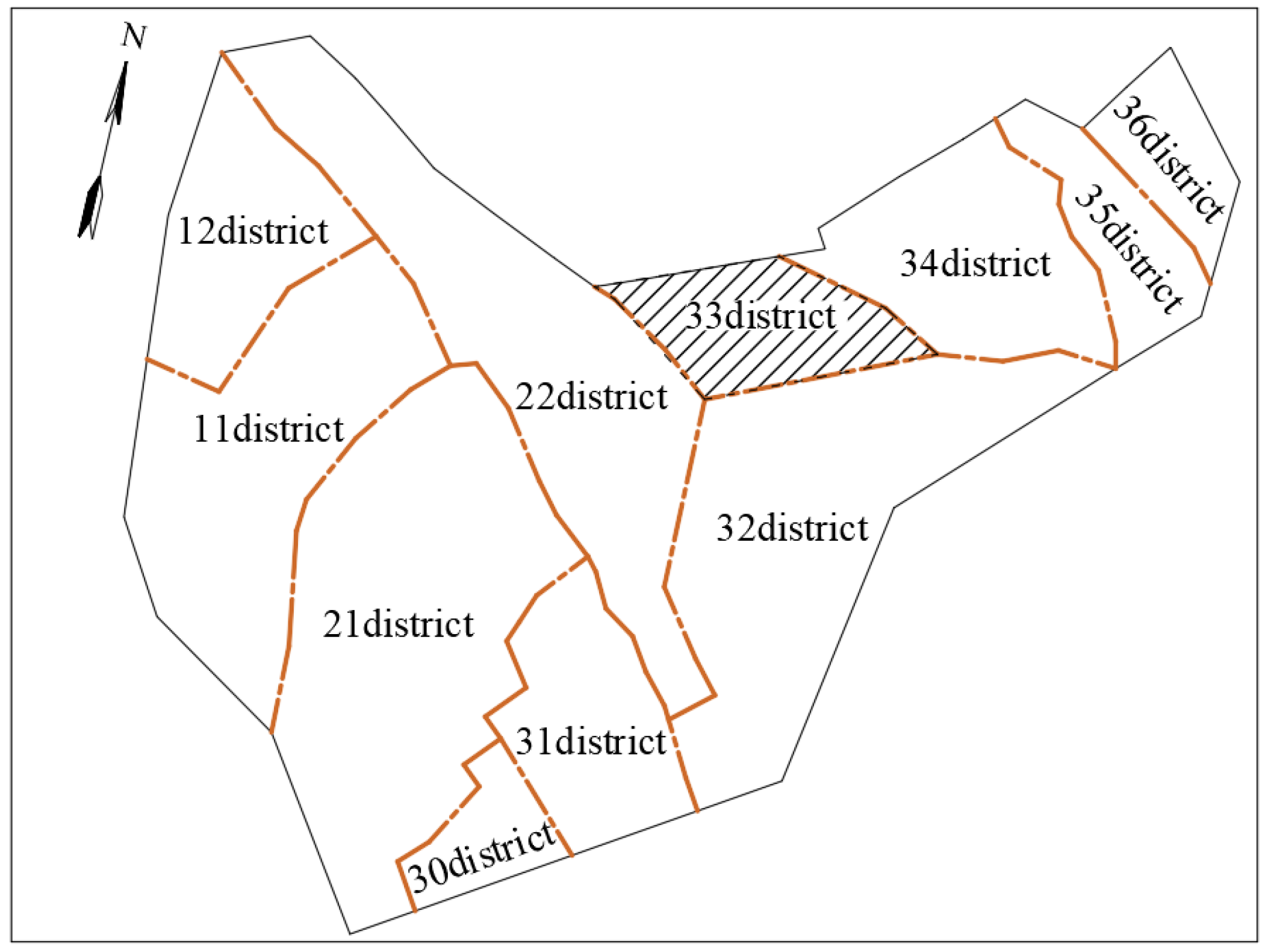
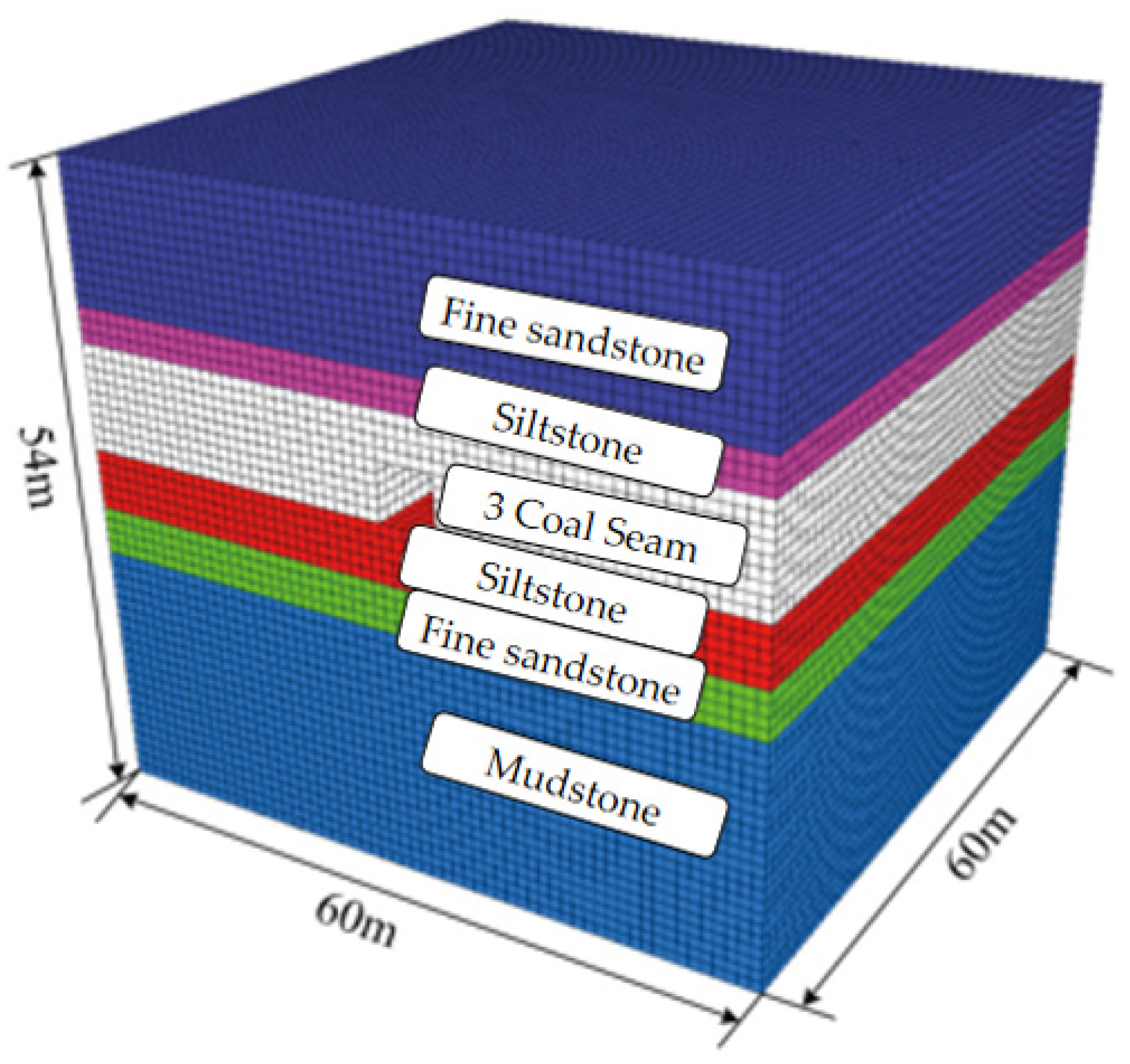






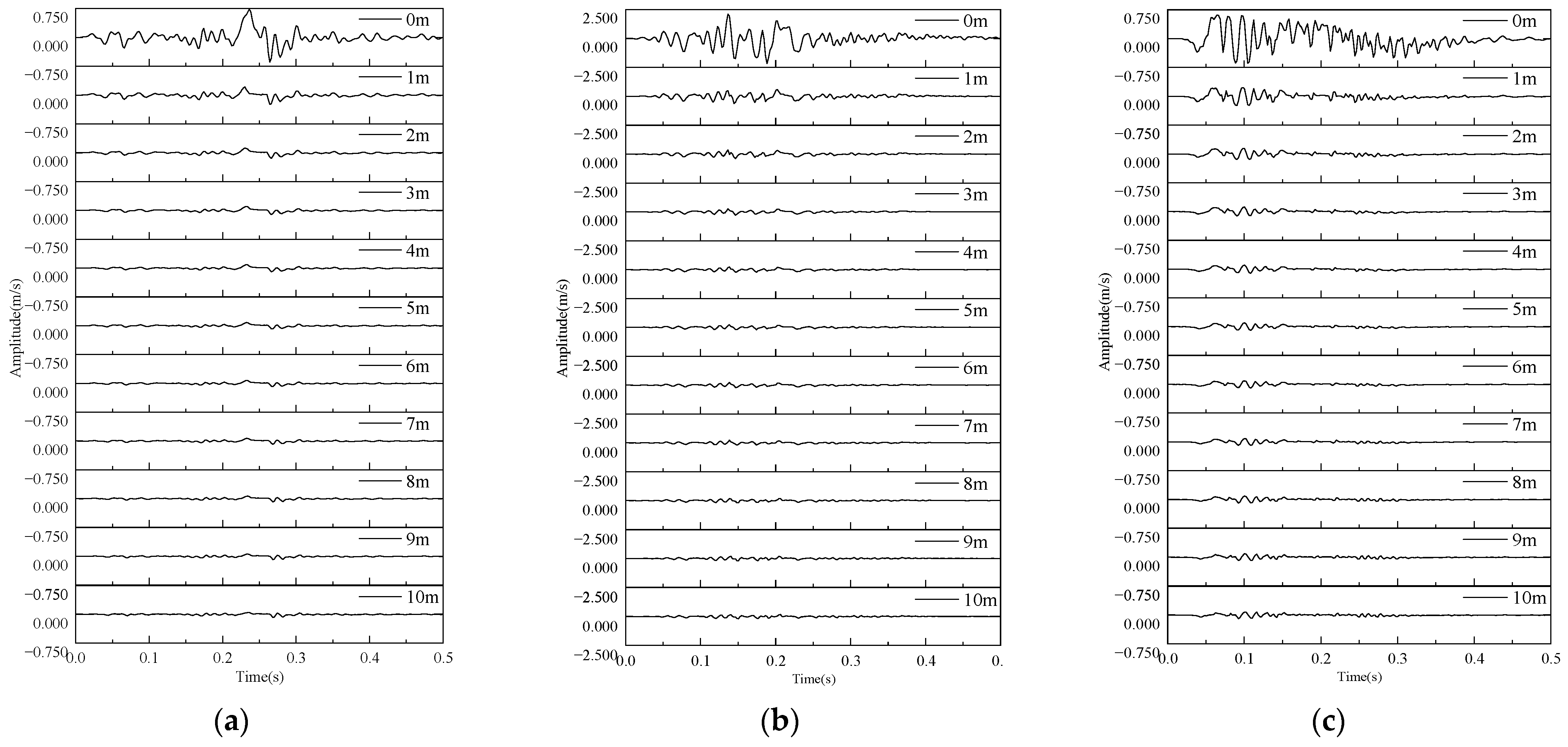
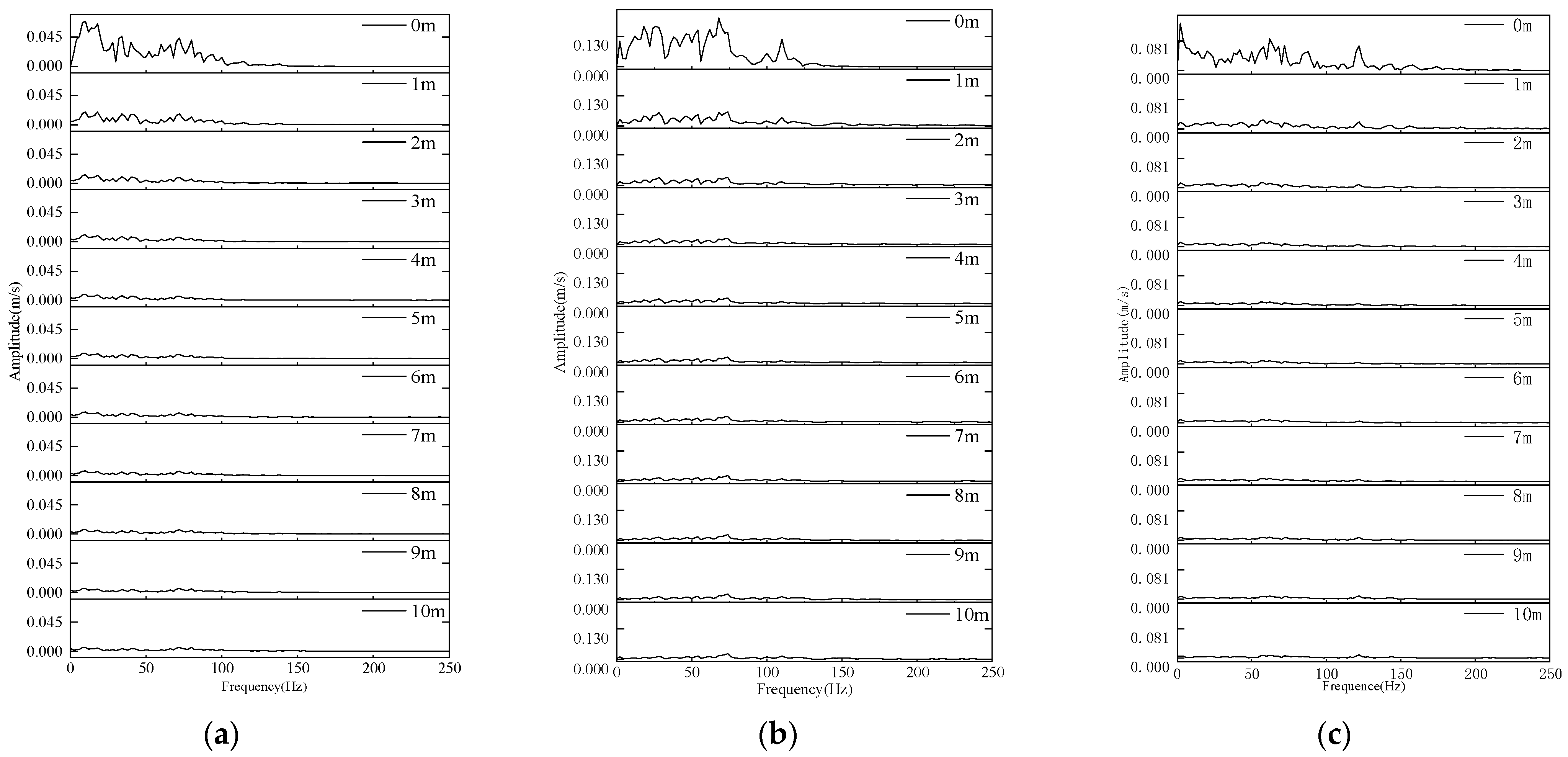
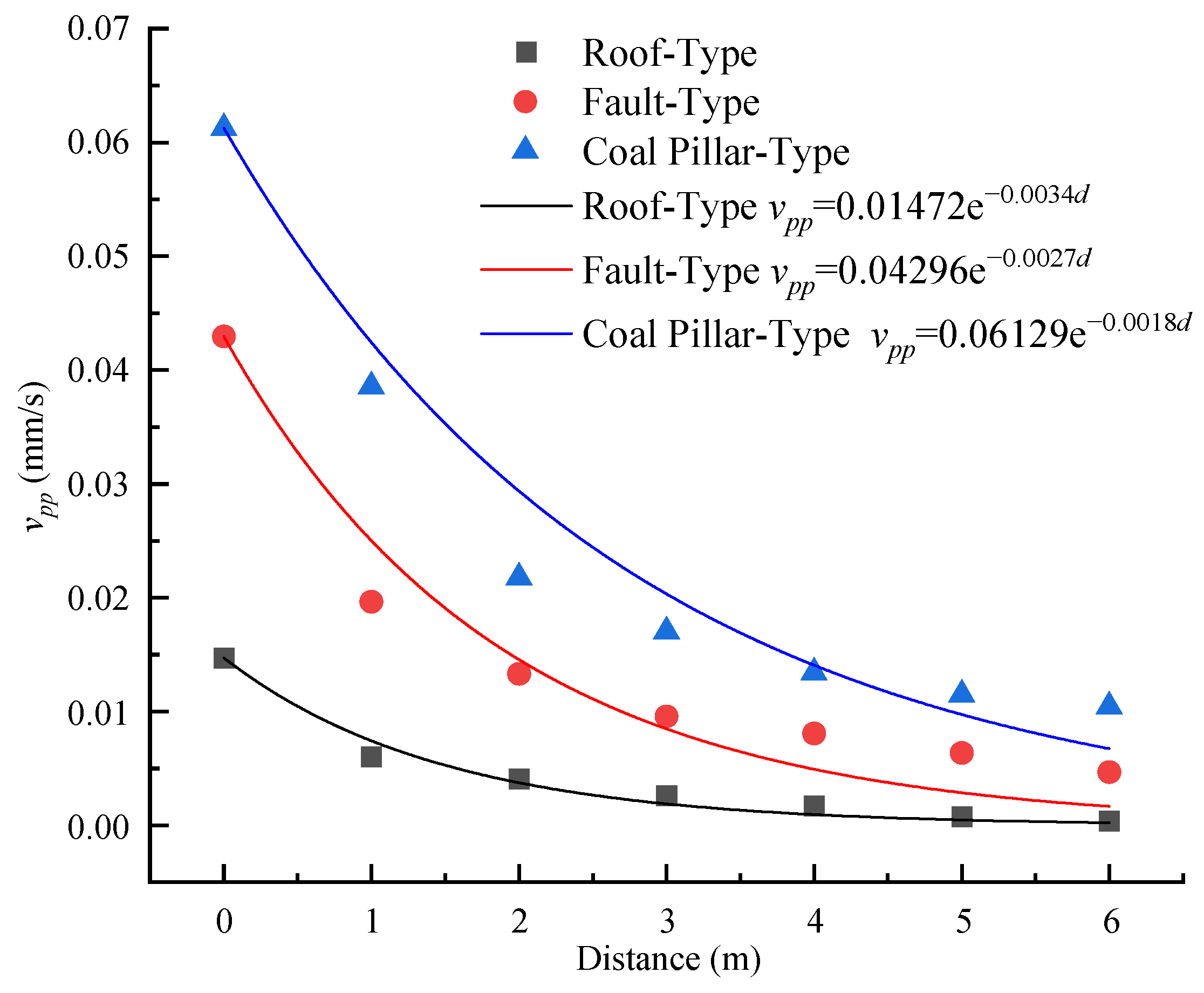
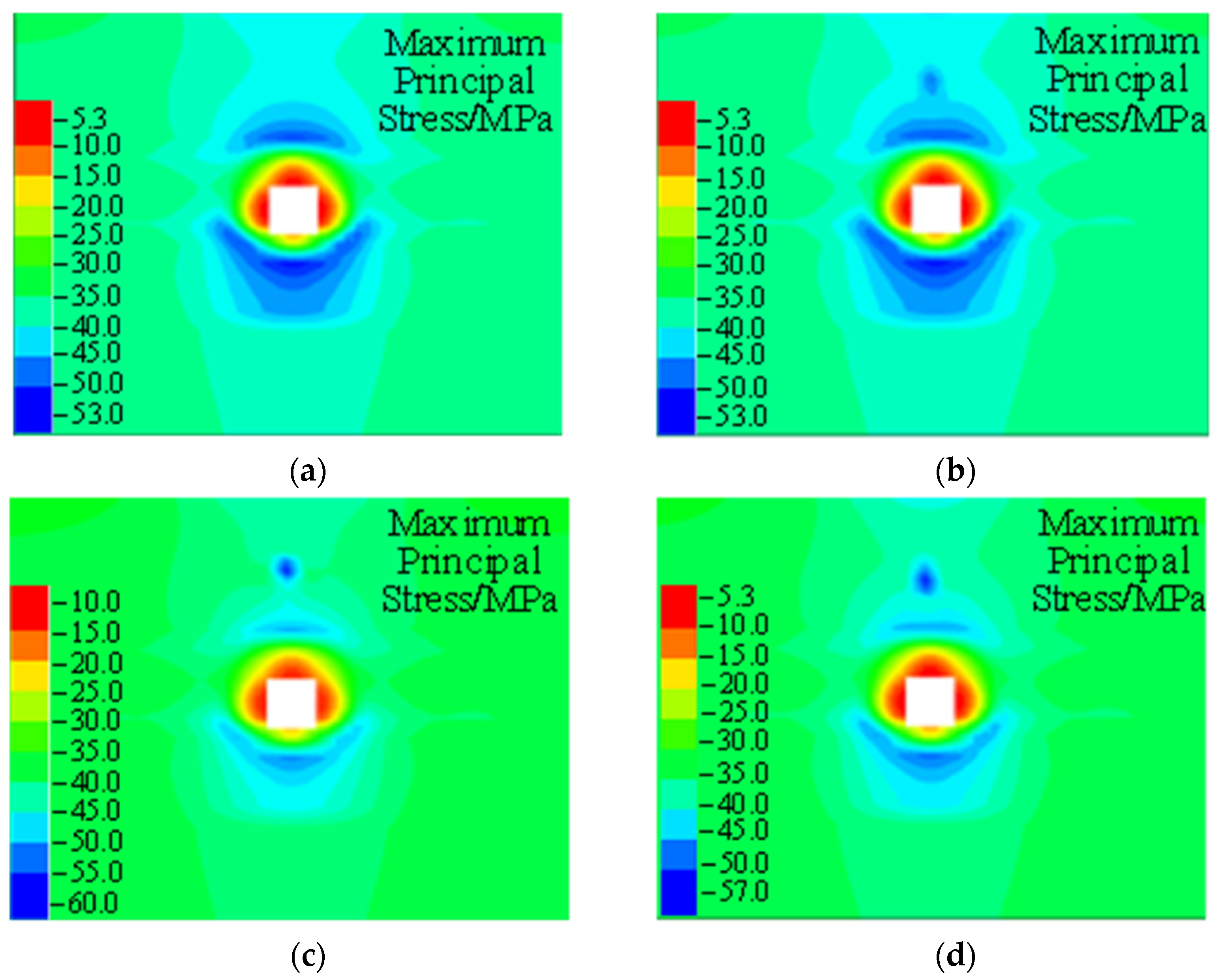




| Event | Ω0/m∙s | f0/Hz | Mark |
|---|---|---|---|
| 1 | 1.29 × 10−7 | 1.83 | D1 |
| 2 | 1.54 × 10−7 | 2.22 | D2 |
| 3 | 2.47 × 10−7 | 10.42 | D3 |
| 4 | 4.56 × 10−7 | 2.09 | B1 |
| 5 | 1.13 × 10−8 | 16.84 | B2 |
| 6 | 1.19 × 10−8 | 37.96 | B3 |
| 7 | 1.62 × 10−8 | 7.19 | M1 |
| 8 | 2.65 × 10−8 | 2.77 | M2 |
| 9 | 6.02 × 10−7 | 9.86 | M3 |
| Event | Seismic Moment/N∙m | Source Radius/m | Radiated Energy/J | Apparent Volume/m3 | Stress Drop/MPa | Apparent Stress/MPa |
|---|---|---|---|---|---|---|
| 1 | 3.08 × 1010 | 85.91 | 2.00 × 104 | 7.89 × 105 | 21.238 | 0.195 |
| 2 | 4.59 × 1010 | 71.66 | 1.00 × 104 | 4.05 × 106 | 63.639 | 0.077 |
| 3 | 1.27 × 1011 | 29.76 | 1.20 × 104 | 5.63 × 107 | 39.378 | 0.153 |
| 4 | 1.03 × 1011 | 75.34 | 1.81 × 104 | 1.54 × 107 | 10.109 | 0.087 |
| 5 | 3.58 × 109 | 9.52 | 1.49 × 104 | 1.96 × 104 | 24.723 | 1.953 |
| 6 | 5.56 × 109 | 4.15 | 1.67 × 104 | 3.09 × 104 | 34.045 | 0.901 |
| 7 | 4.25 × 109 | 36.65 | 1.34 × 104 | 2.26 × 104 | 41.835 | 0.952 |
| 8 | 2.47 × 109 | 56.94 | 1.37 × 104 | 7.40 × 103 | 58.433 | 1.667 |
| 9 | 6.24 × 1010 | 51.88 | 1.60 × 104 | 6.01 × 106 | 15.831 | 0.674 |
| Event | First Main Frequency/Hz | Second Main Frequency/Hz | Frequency Range/Hz |
|---|---|---|---|
| M1 | 13.1 | 30.7 | [10, 40] |
| M2 | 15.6 | 27.6 | |
| M3 | 12.7 | 49.1 |
| Event | First Main Frequency/Hz | Second Main Frequency/Hz | Third Main Frequency | Frequency Range/Hz |
|---|---|---|---|---|
| D1 | 60.8 | 50.8 | 33.1 | [30, 60] |
| D2 | 45.3 | 57.6 | 35.2 | |
| D3 | 69.1 | 38.7 | 8.7 |
| Event | First Main Frequency/Hz | Second Main Frequency/Hz | Third Main Frequency | Fourth Main Frequency | Frequency Range/Hz |
|---|---|---|---|---|---|
| B1 | 61.8 | 39.8 | 12.1 | 23.4 | [40, 80] |
| B2 | 45.7 | 49.4 | 22.9 | 11.1 | |
| B3 | 83.4 | 77.2 | 68.4 | 49.6 |
| Event | Fitting Coefficient m | Decay Coefficient n | R2 |
|---|---|---|---|
| M1 | 1.75 × 10−7 | 3.71 | 0.94896 |
| M2 | 2.22 × 10−6 | 1.09 | 0.84846 |
| M3 | 1.95 × 10−6 | 1.24 | 0.95688 |
| D1 | 4.63 × 10−7 | 1.73 | 0.93215 |
| D2 | 2.41 × 10−6 | 1.09 | 0.77968 |
| D3 | 8.19 × 10−8 | 5.21 | 0.96950 |
| B1 | 2.32 × 10−7 | 4.91 | 0.96279 |
| B2 | 7.73 × 10−8 | 4.14 | 0.81614 |
| B3 | 6.92 × 10−6 | 2.18 | 0.94912 |
| Event | ∆α | ∆f(α) | Event | ∆α | ∆f(α) | Event | ∆α | ∆f(α) |
|---|---|---|---|---|---|---|---|---|
| M1 | 1.172 | −0.697 | D1 | 1.650 | −0.570 | B1 | 1.600 | −0.284 |
| M2 | 1.405 | −0.728 | D2 | 1.527 | −0.598 | B2 | 1.639 | −0.433 |
| M3 | 1.358 | −0.675 | D3 | 1.453 | −0.446 | B3 | 1.626 | −0.366 |
Disclaimer/Publisher’s Note: The statements, opinions and data contained in all publications are solely those of the individual author(s) and contributor(s) and not of MDPI and/or the editor(s). MDPI and/or the editor(s) disclaim responsibility for any injury to people or property resulting from any ideas, methods, instructions or products referred to in the content. |
© 2025 by the authors. Licensee MDPI, Basel, Switzerland. This article is an open access article distributed under the terms and conditions of the Creative Commons Attribution (CC BY) license (https://creativecommons.org/licenses/by/4.0/).
Share and Cite
Ren, W.; Li, J.; Li, X.; Wang, C.; Liu, S.; Qiu, H. Assessing Characteristics of Strong Dynamic Loads in Deep Coal Mining and Their Mechanisms in Triggering Secondary Disasters. Appl. Sci. 2025, 15, 4529. https://doi.org/10.3390/app15084529
Ren W, Li J, Li X, Wang C, Liu S, Qiu H. Assessing Characteristics of Strong Dynamic Loads in Deep Coal Mining and Their Mechanisms in Triggering Secondary Disasters. Applied Sciences. 2025; 15(8):4529. https://doi.org/10.3390/app15084529
Chicago/Turabian StyleRen, Wentao, Jiazhuo Li, Xuwei Li, Changbin Wang, Shun Liu, and Hang Qiu. 2025. "Assessing Characteristics of Strong Dynamic Loads in Deep Coal Mining and Their Mechanisms in Triggering Secondary Disasters" Applied Sciences 15, no. 8: 4529. https://doi.org/10.3390/app15084529
APA StyleRen, W., Li, J., Li, X., Wang, C., Liu, S., & Qiu, H. (2025). Assessing Characteristics of Strong Dynamic Loads in Deep Coal Mining and Their Mechanisms in Triggering Secondary Disasters. Applied Sciences, 15(8), 4529. https://doi.org/10.3390/app15084529






